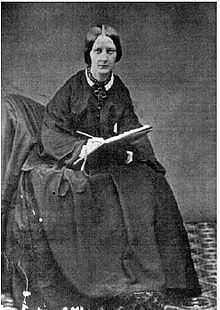Jemima Blackburn
| Jemima Blackburn | |
|---|---|
 Photograph by Alinari of Florence (1852) | |
| Born |
1 May 1823 Edinburgh, Scotland |
| Died |
9 August 1909 (aged 86) Roshven, Moidart, Scotland |
| Nationality | Scottish |
| Known for | Painting |
| Notable work | Birds from Moidart, Birds from Nature |
| Spouse(s) | Hugh Blackburn married 12 June 1849, Edinburgh |
Jemima Wedderburn Blackburn (1 May 1823 – 9 August 1909) was a Scottish painter whose work gives us an evocative picture of rural life in 19th-century Scotland. One of the most popular illustrators in Victorian Britain, she illustrated 27 books. Her greatest ornithological achievement was the second edition of her Birds from Nature (1868). Most of the illustrations are watercolors, with early paintings often including some ink work. A few are collages, in which she cut out a bird’s outline and transferred it to a different background, in a similar manner to John James Audubon. Her many watercolours show daily family life in the late 19th-century Scottish Highlands as well as fantasy scenes from children's fables. She achieved widespread recognition under the initials JB or her married name Mrs Hugh Blackburn.
Life and work
The youngest daughter of James Wedderburn, Solicitor General for Scotland, and a first cousin of James Clerk Maxwell, Jemima was a friend and pupil of John Ruskin and Sir Edwin Landseer, both of whom praised her work highly.[1] She married the mathematician Professor Hugh Blackburn and they bought the Roshven estate in 1854. Her Roshven home became the focus of visits from some of the most celebrated figures of the century, including the Duke of Argyll, Lord Kelvin, Lord Lister, Hermann von Helmholtz, John Ruskin, Sir John Everett Millais, Anthony Trollope and Benjamin Disraeli. Much of her work portrayed Roshven, its animals and birds. She became one of the leading bird painters of the day.
Mrs. Blackburn was a keen observer of bird behavior, as evidenced by her writings. She describes the ejection of nestling Meadow Pipits (Anthus pratensis) by a blind and naked hatchling Common Cuckoo (Cuculus canorus), accompanied by a small drawing. This behavior had been reported by Jenner in 1788 but dismissed as impossible by Charles Waterton in 1836. Blackburn’s account was originally published, not in a scientific journal, but in a popular narrative for children, The Pipits 1871. Charles Darwin refers to Mrs. Blackburn’s observations in the sixth edition of On the Origin of Species.
"...in portraying animals, I have nothing to teach her..." - Sir Edwin Landseer, 1843
In 1857 Jemima was asked to contribute to the first exhibition of contemporary British art in America. Her works have also been exhibited in Edinburgh, Glasgow and London and examples have been acquired by the British Museum, the British Library, the Natural History Museum, Royal Collection, the National Portrait Gallery and more recently by the Scottish National Portrait Gallery and the James Clerk-Maxwell Foundation.
Beatrix Potter describes Jemima in her journal as a "broad intelligent observer with a keen eye for the beautiful in Nature", commenting: "I consider that Mrs Blackburn's birds do not on the average stand on their legs so well as Bewick's, but he is her only possible rival". She also recalls her delight when given for her birthday a copy of Jemima's "Birds drawn from Nature", which was published in 1868 and won immediate public acclaim. A copy of the book, hand coloured under Jemima's own supervision, was presented to the Zoological Society of London.
"...We have seen no such birds since Bewick's. We say this not ignorant of the magnificent plates by Selby, Audubon, Wilson and Gould..." - The Scotsman, 1868
During her life at Roshven, Jemima created for us a priceless legacy of paintings covering every facet of the life and customs of her time. Hardly a day passed without her recording some aspect of her varied and wonderful life. She painted her family and friends, important visitors and local people going about their everyday work: cutting peat, gathering bracken, making hay and many other rural activities. These paintings provide us with a treasured insight into the people and pursuits of her time and of this area.
Besides all this, Jemima's abiding interest lay in the countryside and the wealth of wildlife which it supported. The very best of her work is to be found among her paintings of Roshven, its animals and its birds. It was through this that she became acknowledged as one of the leading bird painters of the day.
Modern reprints of her work
Blackburn, Jemima; Fairley, Rob (1993). Blackburn's birds.
References
- ↑ "Jemima Blackburn (1823 - 1909)". Roshven.com. Retrieved 30 June 2013.
- Blackburn, Jemima (April 1998). Jemima: The Paintings and Memoirs of a Victorian Lady. ISBN 9780862418182.
External links
- Works by Jemima Blackburn at Project Gutenberg
- Works by or about Jemima Blackburn at Internet Archive
|